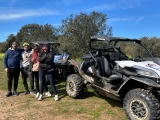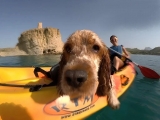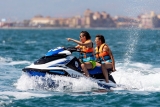This itinerary, where you can practise ski touring, is particularly fascinating: you can experience adventure tourism amidst the most breathtaking landscapes.
The route runs almost entirely across glacial terrain at an average altitude exceeding 3,000 m. Therefore, venturing here requires solid winter mountaineering skills and it's advisable to undertake the route with a group of experienced skiers. A minor disorientation, losing your bearings or sudden bad weather can transform this seemingly straightforward itinerary into a dangerous trap.
Always check the weather forecast and route conditions: with good conditions it will leave an unforgettable memory, but if not, it's better to change objectives or stay on the ski slopes.

Using the Klein Matterhorn cable car allows this traverse to be done with predominantly downhill skiing. Although the total elevation gain across both days doesn't reach 2,000 m, bear in mind the route is long and at high altitude.
Recommended season between March and May. The starting point will be Zermatt (Geneva-Lausanne-Visp, or alternatively Chamonix-Martigny-Visp). From Visp follow the road to Tasch, leave your car in the (paid) Tasch car park and take the train to Zermatt.
1st Stage: Zermatt (1,616 m)-Breithorn (4,164 m)- Monte Rosa Hütte (2,795 m). With 690 m ascent and 1,660 m descent.
In Zermatt, we head to the base station of the cable car system that will take us to Klein Matterhorn. From there, we ski down to the Breithorn plateau (3,780 m altitude) before ascending the Breithorn's summit dome (4,164 m). If the snow is hard or icy, crampons may be necessary. Once at the summit, you can observe most of the Alpine 4,000m peaks, from the nearby Matterhorn or Mont Rosa to more distant ones. Don't miss the opportunity to survey the upcoming route, noting key points and any existing tracks.
Warning: even before the Klein Matterhorn cable car was built, the Breithorn had a reputation as the easiest 4,000m peak in the Alps. This doesn't mean it's without dangers - though it may seem impossible in good weather, storms on the Breithorn plateau frequently cause serious accidents.

From the Breithorn, return to the plateau and follow the ski resort markers towards Plateau Rosa and Theodulpass (approx. 3,300 m), where we leave the marked route to descend the Unter Theodulgletscher, which flows (at 2,500 m) into Gornergletscher. From there we'll ascend it for just over 5 km until reaching Monte Rosa Hütte, our day's endpoint. Beyond the necessary precautions for glacial travel, don't forget to admire the magnificent mountain scenery surrounding us, with peaks like Weishorn, the Matterhorn, Lyskamm or the impressive Monte Rosa.
2nd Stage: Monte Rosa Hütte (2,795 m)-Stockhornpass (3,394 m)-Adlerpass (3,789 m)-Britannia Hütte (3,030 m)-Saas Fee (1,792 m). Features 1,280 m ascent and 2,000 m descent.
From the hut we continue towards Stockhornpass, following tracks through this vast glacial basin with gentle ascents, flats and descents to the foot of Adlerpass. We then climb steeper slopes to overcome the final steep metres to the col. Depending on snow conditions and the group's technical level, roping up may be necessary to cross the pass. From there, descending Allalingletscher takes us to Britannia Hut (3,030 m) and, following ski runs, to Saas Fee village.

Variations: One additional objective for the second day is climbing the magnificent Strahlhorn (4,128 m), easily accessible from Adlerpass. With extra days available, you could also ascend one of Monte Rosa's summits from Monte Rosa Hütte, or climb Allalinhorn (4,027 m) or Alphubel (4,206 m) from Britannia Hut. The easy access to Britannia Hut from Saas Fee's ski runs facilitates meeting up with less experienced companions arriving via the resort's lifts.











